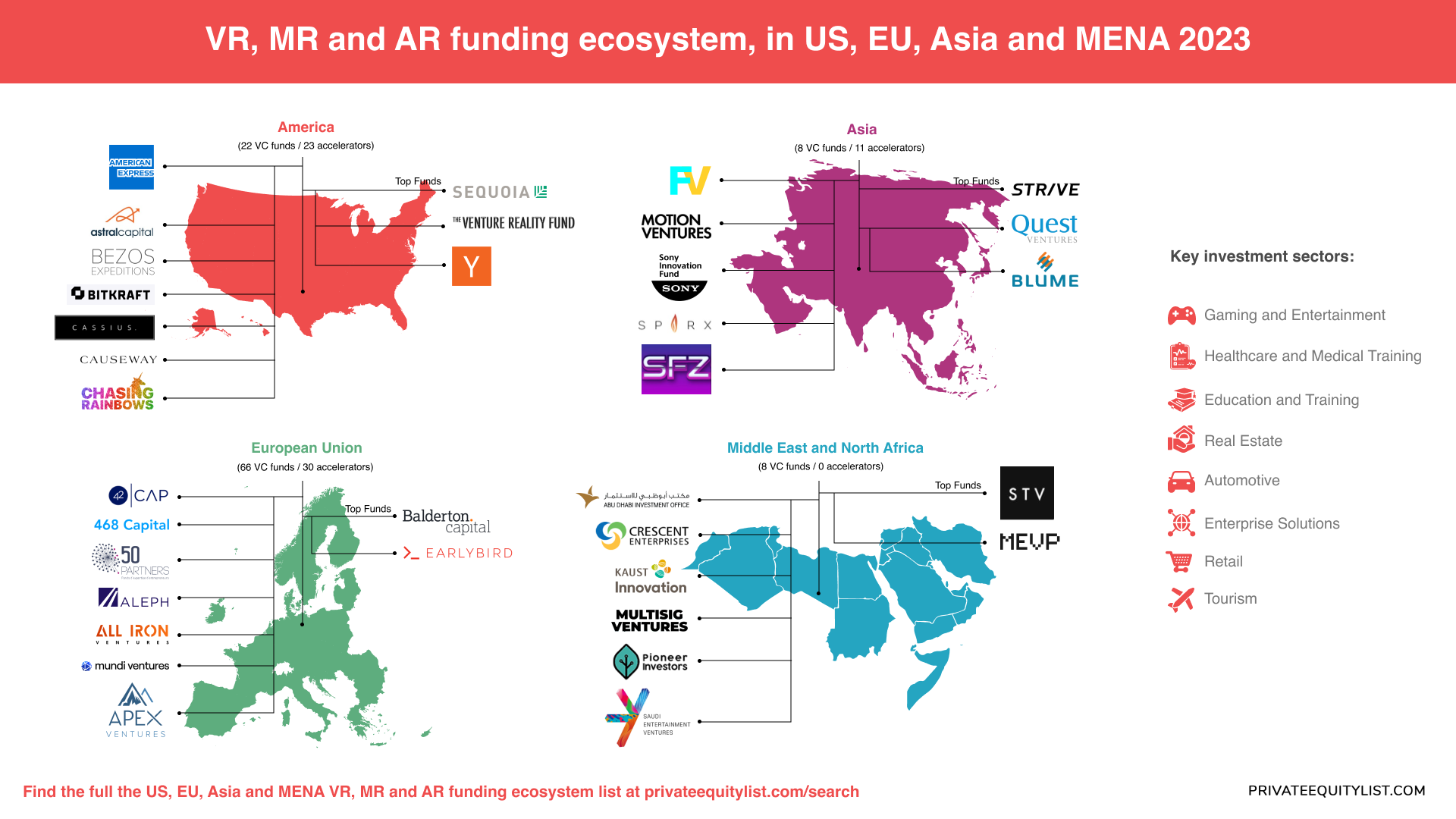In recent years, Virtual Reality (VR), Mixed Reality (MR), and Augmented Reality (AR) have captured the imaginations of entrepreneurs, technologists, and investors around the world. These immersive technologies have the potential to revolutionize industries, from gaming and entertainment to healthcare and education. In this comprehensive guide, we'll delve into the world of VR, MR, and AR investment, focusing on pre-seed and seed rounds. We'll explore the key investment sectors, funding statistics, and the top VC investors across America, the European Union (EU), Asia, and the Middle East and North Africa (MENA).
Funding Statistics and Average Investment Size
Before we dive into the specific regions, it's essential to understand the broader investment landscape for VR, MR, and AR technologies.
In 2021, nearly $3.9 billion of venture came to startups in VR/AR, according to Crunchbase.
Key Investment Sectors
VR, MR, and AR have broad applications that span various sectors. The key investment sectors in this space include:
- Gaming and Entertainment: VR gaming and immersive experiences are gaining significant traction.
- Healthcare and Medical Training: AR is being used in medical training and surgery simulations.
- Education and Training: AR can enhance learning experiences through interactive content.
- Real Estate: MR is revolutionizing property viewing and interior design.
- Automotive: AR heads-up displays are becoming more common in vehicles.
- Enterprise Solutions: VR and AR are used for employee training and collaboration tools.
- Retail: AR apps for shopping and product visualization are becoming popular.
- Tourism: AR-enhanced tourism experiences are on the rise.
Now, let's explore each of the mentioned regions to understand the VC landscape in VR, MR, and AR investments.

America (22 VC funds / 23 accelerators)
America is a hotbed for tech innovation, and the VR, MR, and AR sectors are no exception. Investors in America are enthusiastic about backing startups in this space.
Key local VC funds:
- Sequoia Capital: Known for its investments in companies like Oculus VR, Sequoia Capital is a prominent player in this space.
- The Venture Reality Fund: This fund is dedicated to VR and AR startups.
- Y Combinator: A prestigious accelerator, Y Combinator, has supported VR and AR startups like STRIVR.
More funds:
- American Express Ventures
- Astral Capital Partners
- Bezos Expeditions
- BITKRAFT Esport Ventures
- Cassius Family
- Causeway Media Partners
- Chasing Rainbows
Find the full list here. Such accelerators as VRVCA, Virtual Incubator & Crowdfunding Network and Disruptrs.co are working in the region.
European Union (66 VC funds / 30 accelerators)
The European Union is a diverse region with a burgeoning VR, MR, and AR industry. European investors are actively participating in funding startups in this space.
Key Local VC Funds:
- Balderton Capital (UK): Known for its investments in AR-focused companies like Blippar.
- Earlybird Venture Capital (Germany): Earlybird actively invests in European VR and AR startups.
More funds in the region:
Find the full list via the link. Local accelerators are The Realities Centre, Laval Virtual and Open Call 1- DEVELOP.
Asia (8 VC funds / 11 accelerators)
Asia, with its thriving tech ecosystems, presents an exciting landscape for VR, MR, and AR investments.
Key Local VC Funds:
- Gree Ventures (Japan): Gree Ventures has been investing in AR and VR startups in Japan.
- Quest Ventures (Singapore): This venture capital firm focuses on emerging technologies, including VR and AR.
- Blume Ventures (India): Blume Ventures has invested in AR-based education startups.
More funds:
Find the full list here. Such accelerators as EthAum Venture Partners- Accelerator, TNB Sensing Cities Call & Accelerator and Dreamsoft Innovations Private Limited are operating in the region.
Middle East and North Africa (8 VC funds / 0 accelerators)
The MENA region is steadily gaining prominence in the tech investment scene, including VR, MR, and AR.
Key Local VC Funds:
- STV (Saudi Arabia): STV invests in emerging technologies, including VR and AR.
- MEVP (UAE): MEVP has shown interest in AR-based solutions
More funds:
- Abu Dhabi Investment Office
- Crescent Investments
- KAUST Innovation Fund
- Multisig Ventures
- Pioneer Investors International
- Saudi Entertainment Ventures
For the full list of funds go here.
Key Trends in VR, MR, and AR Investments
As we look forward, there are several key trends in VR, MR, and AR investments that are shaping the industry:
- Consolidation: We can expect to see more mergers and acquisitions in the VR and AR sector as larger companies aim to expand their reach and technology portfolios.
- Healthcare Dominance: The healthcare sector is likely to see substantial growth in AR applications, particularly in surgery simulations and remote medical consultations.
- Education Revolution: VR and AR will continue to transform the education sector, offering students immersive and interactive learning experiences.
- Improved Hardware: Advancements in VR and AR hardware, including more compact and affordable headsets, will make the technology more accessible.
- Metaverse Development: The concept of the metaverse, where virtual and physical worlds merge, is gaining momentum and could be a significant area of investment in the future.
Investing in VR, MR, and AR technologies is not only exciting but also promising. As the industry continues to evolve and expand, investors across America, the EU, Asia, and MENA are actively participating in shaping the future. By understanding the key players, trends, and investment sectors, you can make informed decisions and potentially become a part of this transformative journey. So, whether you're an entrepreneur seeking investment or an investor looking for the next big thing, the world of VR, MR, and AR offers boundless opportunities.
As we have seen, each region has its unique characteristics and key players in the VR, MR, and AR investment landscape. The future of immersive technologies is bright, and with the right knowledge and strategic choices, investors can help propel this exciting industry forward.


